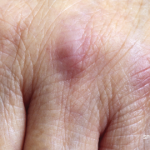The inflammation in the joints of these mice encompasses both innate and adaptive immune mechanisms. The DNase II-/-IFN-IR-/- mice have anti-dsDNA antibodies, and their sera contain high levels of anti-cyclic citrullinated peptide antibody and rheumatoid factor. These mice did develop anti-dsDNA antibodies despite their inability to respond to IFN-I; however, the arthritis-associated antibodies are presumably involved in the dominant phenotype. In collagen-induced arthritis, IFNb ameliorates disease. The inability of DNase II-/-IFN-IR-/- mice to respond to type I interferon is not the cause of joint inflammation as the same phenotype occurs in mice with a postnatally induced deletion of DNase II that requires an IFN-I response to maintain.
In this model, the underlying inflammatory process is more systemic than local synovitis. Early in the disease course, macrophages laden with undigested lysosomal nuclear material produce TNF-a in the bone marrow. Intervention with anti–TNF-a antibodies clinically suppresses disease even at a time point when circulating autoantibodies are likely to be present. The mechanism whereby the excess load of DNA causes the macrophages to release TNF remains unclear. TNF-a release by DNase II deficient macrophages was previously shown to be independent of Toll-like receptor (TLR) signaling. In addition, deletion of DNA-sensing TLR-9 in DNase II-/-IFN-IR-/- had no effect on the development of arthritis.
This report provides a new mouse model for the development of disease and how macrophages may contribute to disease, independently yet in concert, with T and B cells. Most recent work in models with DNase and IFN-1 has focused on their roles in the development and progression of SLE; however, the unexpected phenotype of a inflammatory arthritis resembling rheumatoid arthritis suggests that macrophages elaborating TNF-a early in the disease process may be pivotal in the skewing the later manifestations and disease profile.

